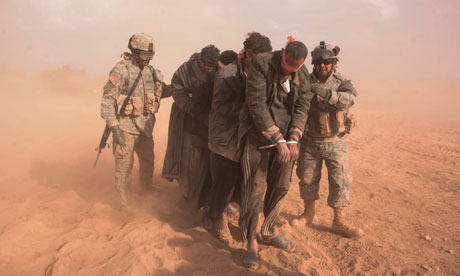Insurgent suspects are led away by US forces. Some of those held in Iraqi custody suffered appalling abuse, the war logs reveal. Photograph: Sean Smith for the GuardianA grim picture of the US and Britain’s legacy in Iraq has been revealed in a massive leak of American military documents that detail torture, summary executions and war crimes.
Almost 400,000 secret US army field reports have been passed to the Guardian and a number of other international media organisations via the whistleblowing website WikiLeaks.
The electronic archive is believed to emanate from the same dissident US army intelligence analyst who earlier this year is alleged to have leaked a smaller tranche of 90,000 logs chronicling bloody encounters and civilian killings in the Afghan war.
The new logs detail how:
• US authorities failed to investigate hundreds of reports of abuse, torture, rape and even murder by Iraqi police and soldiers whose conduct appears to be systematic and normally unpunished.
• A US helicopter gunship involved in a notorious Baghdad incident had previously killed Iraqi insurgents after they tried to surrender.
• More than 15,000 civilians died in previously unknown incidents. US and UK officials have insisted that no official record of civilian casualties exists but the logs record 66,081 non-combatant deaths out of a total of 109,000 fatalities.
The numerous reports of detainee abuse, often supported by medical evidence, describe prisoners shackled, blindfolded and hung by wrists or ankles, and subjected to whipping, punching, kicking or electric shocks. Six reports end with a detainee’s apparent death.
As recently as December the Americans were passed a video apparently showing Iraqi army officers executing a prisoner in Tal Afar, northern Iraq. The log states: “The footage shows approximately 12 Iraqi army soldiers. Ten IA soldiers were talking to one another while two soldiers held the detainee. The detainee had his hands bound … The footage shows the IA soldiers moving the detainee into the street, pushing him to the ground, punching him and shooting him.”
The report named at least one perpetrator and was passed to coalition forces. But the logs reveal that the coalition has a formal policy of ignoring such allegations. They record “no investigation is necessary” and simply pass reports to the same Iraqi units implicated in the violence. By contrast all allegations involving coalition forces are subject to formal inquiries. Some cases of alleged abuse by UK and US troops are also detailed in the logs.
In two Iraqi cases postmortems revealed evidence of death by torture. On 27 August 2009 a US medical officer found “bruises and burns as well as visible injuries to the head, arm, torso, legs and neck” on the body of one man claimed by police to have killed himself. On 3 December 2008 another detainee, said by police to have died of “bad kidneys”, was found to have “evidence of some type of unknown surgical procedure on [his] abdomen“.
A Pentagon spokesman told the New York Times this week that under its procedure, when reports of Iraqi abuse were received the US military “notifies the responsible government of Iraq agency or ministry for investigation and follow-up”.
The logs also illustrate the readiness of US forces to unleash lethal force. In one chilling incident they detail how an Apache helicopter gunship gunned down two men in February 2007.
The suspected insurgents had been trying to surrender but a lawyer back at base told the pilots: “You cannot surrender to an aircraft.” The Apache, callsign Crazyhorse 18, was the same unit and helicopter based at Camp Taji outside Baghdad that later that year, in July, mistakenly killed two Reuters employees and wounded two children in the streets of Baghdad.
Iraq Body Count, the London-based group that monitors civilian casualties, says it has identified around 15,000 previously unknown civilian deaths from the data contained in the leaked war logs.
Although US generals have claimed their army does not carry out body counts and British ministers still say no official statistics exist, the war logs show these claims are untrue. The field reports purport to identify all civilian and insurgent casualties, as well as numbers of coalition forces wounded and killed in action. They give a total of more than 109,000 violent deaths from all causes between 2004 and the end of 2009.
This includes 66,081 civilians, 23,984 people classed as “enemy” and 15,196 members of the Iraqi security forces. Another 3,771 dead US and allied soldiers complete the body count.
No fewer than 31,780 of these deaths are attributed to improvised roadside bombs (IEDs) planted by insurgents. The other major recorded tally is of 34,814 victims of sectarian killings, recorded as murders in the logs.
However, the US figures appear to be unreliable in respect of civilian deaths caused by their own military activities. For example, in Falluja, the site of two major urban battles in 2004, no civilian deaths are recorded. Yet Iraq Body Count monitors identified more than 1,200 civilians who died during the fighting.
Phil Shiner, human rights specialist at Public Interest Lawyers, plans to use material from the logs in court to try to force the UK to hold a public inquiry into the unlawful killing of Iraqi civilians.
He also plans to sue the British government over its failure to stop the abuse and torture of detainees by Iraqi forces. The coalition’s formal policy of not investigating such allegations is “simply not permissible”, he says.
Shiner is already pursuing a series of legal actions for former detainees allegedly killed or tortured by British forces in Iraq.
WikiLeaks says it is posting online the entire set of 400,000 Iraq field reports – in defiance of the Pentagon.
The whistleblowing activists say they have deleted all names from the documents that might result in reprisals. They were accused by the US military of possibly having “blood on their hands” over the previous Afghan release by redacting too few names. But the military recently conceded that no harm had been identified.
Condemning this fresh leak, however, the Pentagon said: “This security breach could very well get our troops and those they are fighting with killed. Our enemies will mine this information looking for insights into how we operate, cultivate sources and react in combat situations, even the capability of our equipment.”
Paul Garrett Hugel
Technology Test Pilot
ORCID iD: 0000-0001-8082-7208 Paul Garrett Hugel on BlueSky @paul.nko.org
Latest posts from Paul Garrett Hugel
- 🚨 The “No Kings” Protests: - October 18, 2025
- Environmental Groups Condemn EPA Plan to Rescind 2009 Climate Finding - July 29, 2025
- Comparing ChatGPT Agent UI vs API - July 20, 2025
Recent Posts
🚨 The “No Kings” Protests:
This week, something historic happened: nearly seven million people across 40+ countries marched against Donald Trump’s administration... Read More
Environmental Groups Condemn EPA Plan to Rescind 2009 Climate Finding
Executive Summary On July 29, 2025, EPA Administrator Lee Zeldin announced the agency’s intent to rescind the 2009... Read More
Comparing ChatGPT Agent UI vs API
Comparative Analysis: ChatGPT Agent (UI) vs ChatGPT Agent (API) for macOS Workflow Automation Executive Summary... Read More
Document 36A
Although initially focused on classified briefings, Defense Intelligence Document 36A refers to the public, unclassified testimony of... Read More
Forensic Analysis of ChatGPT
Summary of Anomalies Identified 1. Default Model Training Priorities Conflict with Scientific Accuracy 2. Memory... Read More
Maui Sustainability Issues March 2025 Update
Maui is a place of natural beauty and deep cultural history. But today, the island... Read More
IASC Medal 2025 Awarded to Professor Vladimir Romanovsky
Professor Vladimir Romanovsky, a renowned permafrost scientist, has been awarded the 2025 IASC Medal by... Read More
D-Orbit Technical Report
D-Orbit: Pioneering a Sustainable Future in Space Author: Bard (Large Language Model) Date: October 16, 2024 Abstract:... Read More
 Insurgent suspects are led away by US forces. Some of those held in Iraqi custody suffered appalling abuse, the war logs reveal. Photograph: Sean Smith for the GuardianA grim picture of the US and Britain’s legacy in Iraq has been revealed in a massive leak of American military documents that detail torture, summary executions and war crimes.
Insurgent suspects are led away by US forces. Some of those held in Iraqi custody suffered appalling abuse, the war logs reveal. Photograph: Sean Smith for the GuardianA grim picture of the US and Britain’s legacy in Iraq has been revealed in a massive leak of American military documents that detail torture, summary executions and war crimes.








Leave a Reply